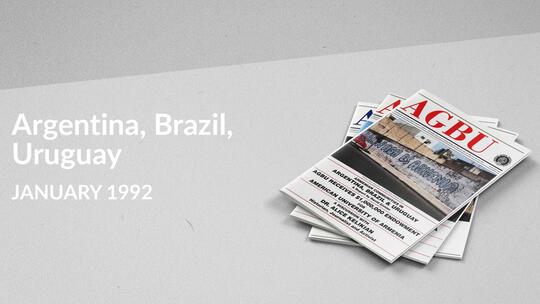by Daloni Carlisle
STEPANAGERD - On Monday, April 13, 1992, Artur Mkrtchian, the President of the Nagorno Karabagh Parliament, sat with a solemn face and told his visitors of the pain it caused him to discuss his people's suffering at the hands of their enemies.
On Tuesday, April 14, he died accidentally by a single bullet, another victim of an escalating struggle for independence and self-determination.
That's life and death in Karabagh today for thousands of people facing an Azerbaijani blockade and a four-year-old territorial dispute which has brought pain, suffering, death and destruction in its wake.
Since January 1, 1992 alone, 360 civilians have died in the conflict and 510 others admitted to hospitals with serious injuries. Hundreds more are missing.
The evening before his death, Mkrtchian, a 33-year-old former economic historian, responded to questions from visiting British journalists about a massacre in the village of Maragha, 130 kilometers from the Nagorno Karabagh capital of Stepanagerd.
"It hurts us to advertise the deaths and to stress the tortures that the people go through in Karabagh," he said in a sad and pensive voice.
The massacre on April 10 had left 50 people dead, including 45 civilians, and 70 houses burnt. When western journalists arrived two days later, the houses were still smoldering.
Villagers showed the group evidence of atrocities they said were carried out by rampaging Azerbaijani and former Soviet army mercenaries. In one place, the remnants of human bones protruded from a pile of ashes where a woman was burnt. In another, flesh and blood stuck to the wall where a man's head was smashed. All around were signs of looting, with intricately carved wooden forks scattered here, a television smashed there.
From a sideroad came a group of women, screaming with grief. Their children were dead; their four and five year old grandchildren were missing, taken off by the soldiers. "I have worked for 40 years," said one. "They destroyed it all."
The schoolyard was a makeshift graveyard; the cemetery was in the firing line. At one end were the stone graves of the Fedayees, the freedom fighters, laid with red carnations. At the other end, men were digging. They wanted to show the west the evidence of atrocities and exhumed two villagers, beheaded and burnt. In the pit stood the grave digger, tears streaming down his face, scrubbing his hands with dirt where he had touched the bodies.
As the men returned to refill the graves, a tank arrived. Armenian Fedayees jumped down, with armfuls of red carnations, and threw themselves on the graves of their friends.
The hospital, 20 kilometers away from Martakert, was operating as best it could from the basement. With no electricity, no running water and a gas supply that was intermittently cut off, it was no different than other hospitals in Karabagh.
There were 11 casualties. They had bullet and shrapnel wounds to their limbs and bodies. Two had bullets in their spines including a man whose entire family was slaughtered while he helped a neighbor under attack.
The massacre at Maragha began at 5:30 a.m. with shelling, a regional commander told the visiting reporters. At lunch time the tanks and armored personnel carriers advanced, followed by up to 1,000 infantry and looters in cars. Help arrived for the villagers at 5:50 p.m. and the attack was repelled at 9 p.m.
When the dust settled, the attack had left the village's 1,500 population badly decimated with 50 dead and 100 missing. The remainder took off to the road with their possessions in carts, heading for who knows what or where.
For many villagers the delays in getting help to Maragha was fatal. According to Mkrtchian, it was unavoidable.
"Incidents like this happen all the time," he said. "Naturally, we divide our forces around the border. The northern region alone has 140 km of frontier with five Azeri regions, each conducting its own attacks. The resources of the two sides simply do not compare," he said.
Editor's note: Ms. Daloni Carlisle is a reporter for Britain's mass-circulation Nursing Times. She was a member of a team of British journalists on a visit to Nagorno Karabagh in early April. The trip was organized by Baroness Caroline Cox, a Deputy Speaker of the British House of Lords.






